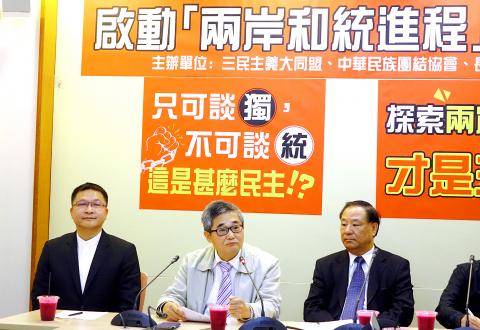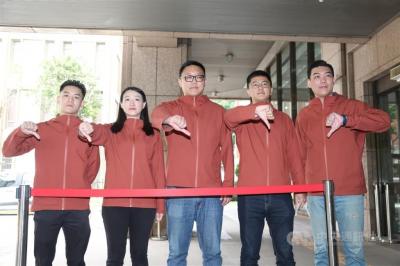Several pro-unification advocates yesterday urged Taiwan’s major political parties to stop reacting to Chinese President Xi Jinping’s (習近平) calls for unification with fear and passiveness, saying that the nation should submit its own version of the “one country, two systems” formula.
Ger Yeong-kuang (葛永光), who is director-general of the Grand Alliance for China’s Reunification Under the Three Principles of the People, said it was a shame that the Chinese Nationalist Party (KMT) and the Democratic Progressive Party responded to Xi’s remarks on Wednesday with a passive attitude.
“In his speech, Xi talked about plans to explore the issue of peaceful unification and a Taiwan version of the one country, two systems formula. Exploration is the emphasis of his remarks, which means his proposals are open to discussions ... even the two systems concept,” Ger told a news conference in Taipei.

Photo:Wang Yi-sung, Taipei Times
While the “one country, two systems” model implemented in Hong Kong places the special administrative region in a subordinate position to Beijing, Ger said that he seeks equality: a cross-strait “merger, rather than an acquisition.”
A system where both sides of the Taiwan Strait unify under a federal system — which could be called the “United States of Zhonghua” or the “United States of China” — would have the People’s Republic of China and the Republic of China assigned appellations of equal status, Ger said.
Zhonghua (中華) is short for Zhonghua minzu (中華民族), which generally refers to people of Chinese ethnicity.
“Such a system would be similar to the one country, two systems concept and we should have our own interpretation of what the two systems should be like,” he said, adding that Taiwanese did not need to fear unification talks.
Alliance secretary-general Lin Chung-shan (林忠山) said it was time that Taiwan stepped out of the conundrum of whether to acknowledge the so-called “1992 consensus” and move toward the process of peaceful cross-strait unification.
The alliance plans to collaborate with two other pro-unification groups to organize eight events before August that would invite people from different political parties and sectors of society to explore the best plan for unification, Lin said.
The events could be in the form of seminars, speeches or forums, Lin said, adding that six would be held in the special municipalities, with the other two planned for eastern Taiwan and one in the outlying counties.
Asked whether unification was a long way from mainstream public opinion, Lin said polls have shown that 40 percent of the nation’s young people would be willing to study or work in China, which indicates there is a tendency for people to think about unification, but not talk about it.

Taiwan is stepping up plans to create self-sufficient supply chains for combat drones and increase foreign orders from the US to counter China’s numerical superiority, a defense official said on Saturday. Commenting on condition of anonymity, the official said the nation’s armed forces are in agreement with US Admiral Samuel Paparo’s assessment that Taiwan’s military must be prepared to turn the nation’s waters into a “hellscape” for the Chinese People’s Liberation Army (PLA). Paparo, the commander of the US Indo-Pacific Command, reiterated the concept during a Congressional hearing in Washington on Wednesday. He first coined the term in a security conference last

Prosecutors today declined to say who was questioned regarding alleged forgery on petitions to recall Democratic Progressive Party (DPP) legislators, after Chinese-language media earlier reported that members of the Chinese Nationalist Party (KMT) Youth League were brought in for questioning. The Ministry of Justice Investigation Bureau confirmed that two people had been questioned, but did not disclose any further information about the ongoing investigation. KMT Youth League members Lee Hsiao-liang (李孝亮) and Liu Szu-yin (劉思吟) — who are leading the effort to recall DPP caucus chief executive Rosalia Wu (吳思瑤) and Legislator Wu Pei-yi (吳沛憶) — both posted on Facebook saying: “I

The Ministry of Economic Affairs has fined Taobao NT$1.2 million (US$36,912) for advertisements that exceed its approved business scope, requiring the Chinese e-commerce platform to make corrections in the first half of this year or its license may be revoked. Lawmakers have called for stricter enforcement of Chinese e-commerce platforms and measures to prevent China from laundering its goods through Taiwan in response to US President Donald Trump’s heavy tariffs on China. The Legislative Yuan’s Finance Committee met today to discuss policies to prevent China from dumping goods in Taiwan, inviting government agencies to report. Democratic Progressive Party Legislator Kuo Kuo-wen (郭國文) said

Sung Chien-liang (宋建樑), who led efforts to recall Democratic Progressive Party (DPP) Legislator Lee Kun-cheng (李坤城), was released on bail of NT$80,000 today amid outcry over his decision to wear a Nazi armband to questioning the night before. Sung arrived at the New Taipei District Prosecutors’ Office for questioning in a recall petition forgery case last night wearing a red armband bearing a swastika, carrying a copy of Adolf Hitler’s Mein Kampf and giving a Nazi salute. Sung left the building at 1:15am without the armband and covering the book with his coat. Lee said today that this is a serious